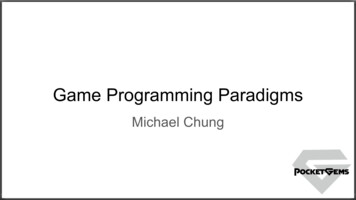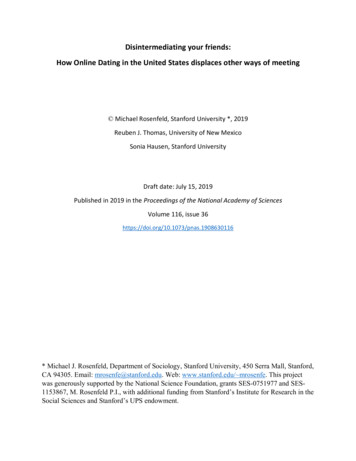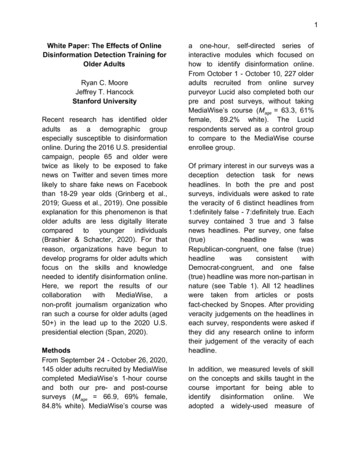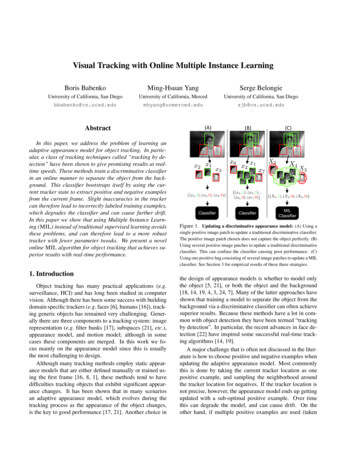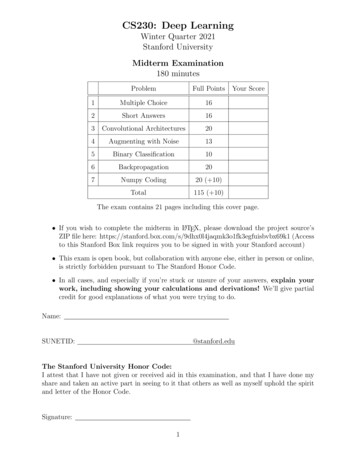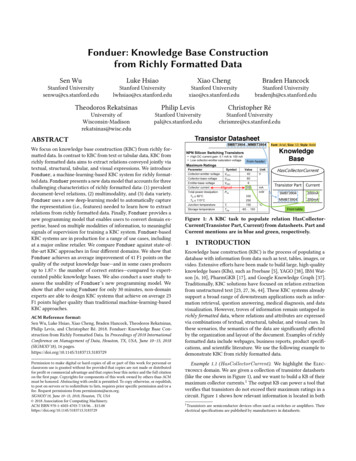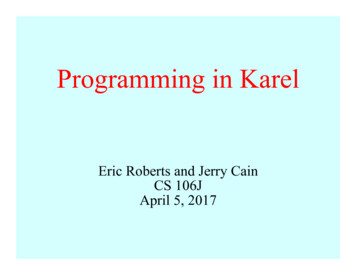
Transcription
Programming in KarelEric Roberts and Jerry CainCS 106JApril 5, 2017
Once upon a time . . .
Rich Pattis and Karel the Robot Karel the Robot was developed byRich Pattis in the 1970s when he wasa graduate student at Stanford. In 1981, Pattis published Karel theRobot: A Gentle Introduction to theArt of Programming, which became abest-selling introductory text. Pattis chose the name Karel in honorˇof the Czech playwright Karel Capek,who introduced the word robot in his1921 play R.U.R. In 2006, Pattis received the annualaward for Outstanding Contributionsto Computer Science Education givenby the ACM professional society.Rich Pattis
Review: Primitive Karel Commands On Monday, you learned that Karel understands the eeper()Move forward one squareTurn 90 degrees to the leftPick up a beeper from the current squarePut down a beeper on the current square At the end of class, we designed a Karel program to solve thefollowing problem:3 3 2 2 1 1 1234512345
The MoveBeeperToLedge Program/** File: MoveBeeperToLedge.k* ------------------------* This program moves a beeper to a ledge.*/function moveBeeperToLedge() ve();}
Syntactic Rules and Patterns The definition of MoveBeeperToLedge on the preceding slideincludes various symbols (such as curly braces, parentheses,and semicolons) and special keywords (such as function)whose meaning may not be immediately clear. These symbolsand keywords are required by the syntactic rules of the Karelprogramming language, in much the same way that syntacticrules govern human languages. When you are learning a programming language, it is oftenwise to ignore the details of the language syntax and focusinstead on learning a few general patterns. Karel programs,for example, fit a common pattern in that they define one ormore functions that describe the steps Karel must perform inorder to solve a particular problem.
Defining New Functions In Karel—and in JavaScript as you will see beginning nextweek—a function is a sequence of statements that has beencollected together and given a name. All functions in Karelhave the following form:function name() {statements that implement the desired operation} The first function in a Karel program is the main function,which is called when you press the Run button at the bottomof the screen. Most Karel programs define additional helper functions thatimplement individual steps in the complete solution.
The turnRight Function As a simple example, the following function definition allowsKarel to turn right by executing three turnLeft operations:function turnRight() {turnLeft();turnLeft();turnLeft();} Once you have made this definition, you can use turnRightin your programs in exactly the same way you use turnLeft. In a sense, defining a new function is analogous to teachingKarel a new word. The name of the function becomes part ofKarel’s vocabulary and extends the set of operations the robotcan perform.
Helper Functions in a Programfunction moveBeeperToLedge() Right();move();putBeeper();move();}/* Turns Karel right 90 degrees */function turnRight() {turnLeft();turnLeft();turnLeft();}
Exercise: Defining functions Define a function turnAround that turns Karel around 180 .function turnAround() {turnLeft();turnLeft();} The turnRight and turnAround functions are so importantthat they are included in a library called "turns". Define a function backup that moves Karel backward onesquare, leaving Karel facing in the same direction.function backup() {turnAround();move();turnAround();}
Control Statements In addition to allowing you to define new functions, Karelalso includes statement forms that allow you to change theorder in which statements are executed. Such statements arecalled control statements. The control statements available in Karel are:– The repeat statement, which repeats a set of statements apredetermined number of times.– The while statement, which repeats a set of statements as longas some condition holds.– The if statement, which applies a conditional test to determinewhether a set of statements should be executed at all.– The if-else statement, which uses a conditional test to choosebetween two possible actions.
The repeat Statement In Karel, the repeat statement has the following form:repeat (count) {statements to be repeated} As with the other control statements, the repeat statementconsists of two parts:– The header line, which specifies the number of repetitions– The body, which is the set of statements to be repeated The keyword repeat and the various punctuation marksappear in boldface, which means that they are part of therepeat statement pattern. The things you can change appearin italics: the number of repetitions and the statements in thebody.
Using the repeat Statement You can use repeat to redefine turnRight as follows:function turnRight() {repeat (3) {turnLeft();}} The following function creates a square of four beepers,leaving Karel in its original position:function makeBeeperSquare() {repeat (4) {putBeeper();move();turnLeft();}}
Conditions in Karel Karel can test the following conditions:positive conditionnegative ngWest()notFacingWest()
The while Statement The general form of the while statement looks like this:while (condition) {statements to be repeated} The simplest example of the while statement is the functionmoveToWall, which comes in handy in lots of programs:function moveToWall() {while (frontIsClear()) {move();}}
The if and if-else Statements The if statement in Karel comes in two forms:– A simple if statement for situations in which you may or maynot want to perform an action:if (condition) {statements to be executed if the condition is true}– An if-else statement for situations in which you must choosebetween two different actions:if (condition) {statements to be executed if the condition is true} else {statements to be executed if the condition is false}
Exercise: Creating a Beeper Line Write a function putBeeperLine that adds one beeper toevery intersection up to the next wall. Your function should operate correctly no matter how farKarel is from the wall or what direction Karel is facing. Consider, for example, the following function called test:function test() 2345
Climbing Mountains For the rest of today, we’ll explore the use of functions andcontrol statements in the context of teaching Karel to climbstair-step mountains that look something like this:43211234567891011 The initial version will work only in this world, but laterexamples will be able to climb mountains of any height.
The End
Art of Programming, which became a best-selling introductory text. Pattis chose the name Karel in honor of the Czech playwright Karel Capek, who introduced the word robot in his 1921 play R.U.R. In 2006, Pattis received the annual award for Outstanding Contributions to Computer Science Education given by the ACM professional society.
